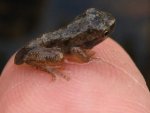Bill
New member
- Joined
- Jun 2, 2009
- Messages
- 16
- Reaction score
- 0
- Points
- 0
- Location
- Lancaster, PA
- Country
- United States
Excuse the off topic question; this site is the best place I know for amphibian info. We just morphed a p. crucifer and I need to quickly move it to its own habitat, before this evening when the hulking 1/2" wood frog comes out for his evening prowl and enjoys the new peeper in all the wrong ways.
This is an extremely small creature, and I do not know how to present it with food. There is a Petsmart nearby.
Any help would be appreciated.
This is an extremely small creature, and I do not know how to present it with food. There is a Petsmart nearby.
Any help would be appreciated.

